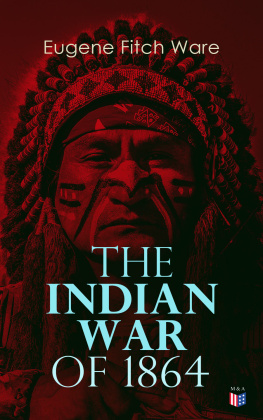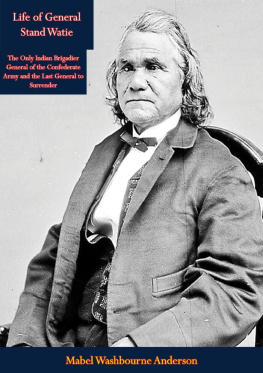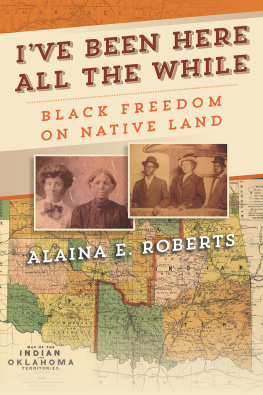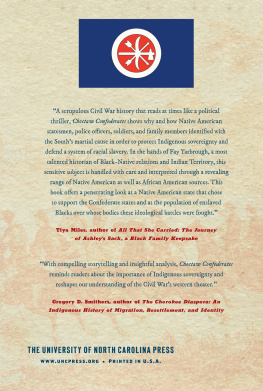Civil Warera Indian Territory places and regional battle sites. Map courtesy of Joseph Swain.
When the Wolf Came
The Civil War and the Indian Territory
Mary Jane Warde
The University of Arkansas Press
Fayetteville
2013
Copyright 2013 by The University of Arkansas Press
All rights reserved
Manufactured in the United States of America
ISBN-10: 1-55728-642-6
ISBN-13: 978-1-55728-642-0
Library of Congress Cataloging-in-Publication Data
Contents
The Civil War in the West has a single goal: to promote historical writing about the war in the western states and territories. It focuses most particularly on the Trans-Mississippi theater, which consisted of Missouri, Arkansas, Texas, most of Louisiana (west of the Mississippi River), Indian Territory (modern-day Oklahoma), and Arizona Territory (two-fifths of modern-day Arizona and New Mexico) but encompasses adjacent states, such as Kansas, Tennessee, and Mississippi, that directly influenced the Trans-Mississippi war. It is a wide swath, to be sure, but one too often ignored by historians and, consequently, too little understood and appreciated.
Topically, the series embraces all aspects of the wartime story. Military history in its many guises, from the strategies of generals to the daily lives of common soldiers, forms an important part of that story, but so, too, do the numerous and complex political, economic, social, and diplomatic dimensions of the war. The series also provides a variety of perspectives on these topics. First, and most important, it offers the best in modern scholarship, with thoughtful, challenging monographs. Second, it presents new editions of important books that have gone out of print. And third, it premieres expertly edited correspondence, diaries, reminiscences, and other writings by participants in the war.
It is a formidable challenge, but by focusing on some of the least familiar dimensions of the conflict, The Civil War in the West significantly broadens our understanding of the nations most pivotal and dramatic story.
Scholarly assessments of the roles played by American Indians in the Civil War have been mostly episodic. We know something of William Holland Thomass raids in North Carolina and Tennessee. Mention of the massacre at Sand Creek often elicits a nod of recognition. The actions of one thousand Indian troopsmostly Cherokeeat Pea Ridge have received ample attention and comment. Nevertheless, most students of the war have only the vaguest idea of how that conflict unfolded in the Indian Territory or how it determined the fate of its people.
The classic study of the war in Indian Territory is The American Indian as Participant in the Civil War, published in 1919, by Annie Heloise Abel. Subsequent scholars have enhanced, amended, and expanded Abels pioneering effortmost notably Laurence M. Hauptman, Between Two Fires: American Indians in the Civil War (1995)but none has entirely supplanted it. And no wonder. It is a complex subject.
The peoples of Indian Territory found themselves in the midst of a war not of their choosing, squeezed between Union Kansas and Confederate Texas, with Confederate Arkansas as their eastern neighbor. They had no way to escape the conflict and no alternative but to suffer the consequences of the national upheaval.
Mary Jane Warde has devoted many years to researching and preserving the history of the old Indian Territory. Built on a solid foundation of published and unpublished sources, including such rich archival collections as the records of Cherokee, Choctaw, and Creek Nations, the present work demonstrates the impressive scope of her knowledge. From the removal acts of the 1830s to the postCivil War readjustment of the western tribes, her sweeping narrative explores both the signal public events that marked that tumultuous era and the consequences for the territorys tens of thousands of native peoples. More than a story of the Indian Territory during the war, it is a strikingly new version of the standard story of the Civil War era, from the antebellum years through Reconstruction.
T . M ICHAEL P ARRISH
D ANIEL E . S UTHERLAND
Even after 150 years we still live every day with the aftermath of the Civil War in the Indian Territory. Developments in neighboring states assured that the Indian Territory would be drawn into the Civil War, while what happened in the Indian Territory washed over into those states. The war in the Indian Territory also made possible the gathering of native peoples into this space now called Oklahoma, which affected the national development of the United States. Consequently, at least ten states besides Oklahoma, from the Great Plains to the Pacific Coast, felt the impact of the Civil War in the Indian Territory.
As might be expected, this account describes politics, battles, leaders, and fighting men. It is also a personal history of the war in the Indian Territory. More than anywhere else, the Civil War directly involved red, black, and white peoplemen, women, and childrenhousewives, farmers, politicians, hunters, slaves, teachers, ministers, merchants, and doctors.
Fortunately, since 1934 the Oklahoma Historical Society Archives, now the Research Division, has been the guardian of much documentation of the Civil War and its impact on the Trans-Mississippi West. This includes Indian national and tribal records, the manuscript and historic map collections, the oral history collections, and the photograph and newspaper archives. The Friends of the Oklahoma Historical Society Archives, founded in 1996, understand the importance of not only maintaining that wealth of historical information but also of adding to it. We Friends also remember decades of service the staff has extended to scholars working on the next publication, genealogists tracking an ancestor, History Day students learning how to research a topic, and tribal people searching for recordings of old songs in danger of being lost forever.
This book, then, has been a collegial effort of the Friends, scholars, and Indian people who know, love, and value our history. We want to continue the work of collecting historical materials as they are discovered or generated today, preserving them, and making them accessible as technology changes. We hope this book will serve two purposes: educating those who want to know more about the causes, events, and long-term impact of the Civil War in the Indian Territory and generating supplemental funding to support the work the Oklahoma Historical Society Archives staff began more than seven decades ago.
Many, many people encouraged me in this project, and I will be forever grateful to them. The idea for this book was born in classes I taught for the Osher Lifelong Learning Institute. Special thanks go to William D. Welge, then director of the Oklahoma Historical Society Research Division; Chad Williams, his successor; and the Photo Archives staff. John Phillips and the staff at Edmon Low Library, Oklahoma State University, have been helpful as always. Those who supported the project on faith include the Friends Board of Directors and President Denise Dennison. Fellow Friends Roberta Clardy,










